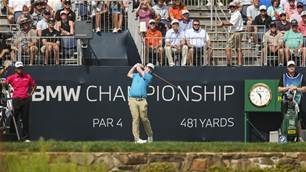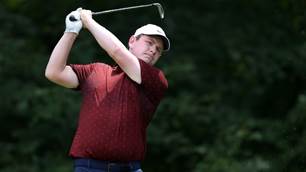Former club vice-captain Alan Harrison reckons “there wasn’t any one magical thing” which resulted in so many Federal juniors exploring careers in golf, but the greater environment was a very healthy one for aspiring youngsters.
... Harrison, says “the course was tough in those days”.
“It was long, a bit up-and-down, and the bush was unyielding. If you were a two- or four-marker, you would be genuinely shooting 74 or 76 most often. It wasn’t an aspiration to make 36 points, it was par,” Harrison says.
Andrew Welsford says “the course was awesome back in the pre-couch fairways, though they are amazing today”.
“But it was the atmosphere of being around so many good players, and testing yourself against each other. It was a brilliant way to learn the game. [Head professional] Glenn Cassells was such a huge part of the culture, as were numerous members,” Welsford says.
The author’s old man was one. So was Rob Richardson’s dad, John. Harrison, Gus Donald, Paul “Woofer” Arnold, Pete Post and Brian Ratcliffe encouraged the boys and kept them in line. Terry O’Donoghue ran tournaments. Gary Trotman ran trainee tournaments. Cassells, himself a former junior, took them on as trainees. If they couldn’t get a start at Federal – there were only so many spots – Royal Canberra, Murrumbidgee or any other course would find a spot for them.
“I did mine through Pete Kohlsdorf, who ran Pete’s Golf Connection in Fyshwick,” Col Swatton says. “I wanted to be a ski instructor. Spend the summers in Japan, winter in the U.S. People said, no, you’re a good golfer, get a traineeship. I knew I wasn’t good enough to get it at Federal or Royal Canberra. And I knew I wasn’t good enough to play professionally. But I loved teaching. So Pete said, if you can beat me over 18 holes, you’ve got the job. Took a birdie on 18, but I did!”
View this post on Instagram
Swatton worked for nearly three years at Murrumbidgee, took off to Singapore at the invite of former Federal pro Mark Higgs, had four years in Kuala Lumper, returned home when his father passed away, before a chance meeting in a golf shop with a Federal member (of course) took Swatton to Kooralbyn International School where he met Day.
Welsford’s journey was similarly circuitous. According to Craig Carmichael, he had the sweetest swing of them all. “Welsy turned up aged 16 without having touched a club, and was in single figures within a month,” Carmichael says. “By age 18 he was a trainee professional. He turned pro before I did.”
Richardson – who would be a teaching professional in Singapore, Malaysia, Israel and Dreamland near the great Pyramids in Cairo – won the club championship twice, aged 18 and 20. For him, playing golf at Federal was just what he did. “We didn’t have phones. It was what you did on Saturdays. And Sundays. And Tuesday afternoons: go hit some balls and see how much you could spin those balata balls off the greens. It was fun. It was your recreation,” Richardson says.
View this post on Instagram
“Fruitbat got so good, he could airmail a wedge over the first green, and have so much spin on it that it would come back up the hill and onto the green.”
“Fruitbat” – Mark Batten – turned professional under Glenn Cassells, and today teaches at Meadow Springs in Mandurah, south of Perth. Then he was the number-one player of a gun quintet which won the ACT Junior Pennant and then lined up as 1-5 in the Senior Pennant team. Of the eight players from the Junior team, six turned professional.
The club rallied behind them. Members loved it that the kids knocked over “big brother” Royal Canberra. While Federal bought into the youngsters’ success, Royal had been a bit upset, according to Harrison, that the youngsters were also playing Senior Pennant. “We told Royal, ‘There’s no rule against it. They’re the best players in our club. We’ll play ‘em!’
“And suddenly these kids have all gone off. And then, virtually almost all at once, they all did professional traineeships.”

Harrison reckons “there wasn’t any one magical thing” which resulted in so many Federal juniors exploring careers in golf, but the greater environment was a very healthy one for aspiring youngsters.
“It was the fact that these kids were so good and they fed off each other. They were supportive of each other and pushed each other,” Harrison says. “They went to school together, lived together, lived nearby each other.
Critically, a new membership category of sub-junior – aged 12-14 – was instituted at Federal. Scott Barr joined on his 12th birthday. So did Craig Carmichael. He began as a 31-marker, “a week later I blew out to 32,” he quips. He was single figures by 14, scratch by 16. Barr had similar progression.
“The club basically embraced us, said, ‘Okay, we’ve got a bunch of good young guys here. Let’s bring them up and into it,’” Carmichael says. “There were proper training and practice sessions, all that sort of stuff. We didn’t have professional coaches, but we treated it pretty professionally for a bunch of 15-,16-, 17-year-olds.”
“It was really cool,” Col Swatton says. “We’d all have lockers there with our clubs and stuff in them. We’d ride our bikes up there, have a good time, play golf all day. You’d play 36 holes, have a Coke and a bag of chips. By the time we were 18 we’d have a beer, play the pokies. It was great.”
View this post on Instagram
Carmichael says a crucial factor was the feeling the juniors had from being part of the club. They represented. It was their club.
“It wasn’t the Ryder Cup or Presidents Cup,” he says, “but we were a team, a club. And the membership and the Pro Shop got behind us.
“Terry O’Donoghue was the old pro there, and he was heavily involved in tournament golf, so he was a good sounding board. He always encouraged the young players to get out there and grind.
“And there was a good little core group of us. We’d get dropped off in the school holidays at 8 o’clock in the morning, picked up at 6 o’clock at night. You’d play 36 holes, have chipping comps, putting comps. They let us play Saturdays. After a while they’d book a block of eight and put us in with some of the senior Pennant guys, and you’d play for a few dollars. And that could get the juices flowing, for sure.”
“And we began to push each other. It was competitive amongst us, and the club was supportive. They never said, ‘You can’t play on Saturday.’ You’re talking in the ’80s. Clubs would have rules that two juniors couldn’t play together. But Federal was totally supportive.”
Murray Blair agrees. Though the stuffiness of Old Golf had tendrils. “You couldn’t book yourself in on Saturdays, you had to put yourself on a waiting list,” Blair says. “But it had the effect of bringing you into the club as well. You’d find yourself in a group with three people you didn’t know and you learned to speak to adults. You learned respect.”
Swatton says the club was full of like-minded people. “I’m a firm believer that you become the people that you hang around with. We were all focused, level headed – [laughs] well, for 16-year-olds! But we all had a good time and we knew we wanted to play golf, and we knew that we wanted some sort of job within the golf industry.
“You put a bunch of kids together who are all like-minded with similar goals, and you’re going to see something come out of that. And I think that’s what Federal was: a melting pot of good kids who were focused on the game and a career in it.
“My biggest memory, though, was that it was a cool place to hang out and be a part of. It was really, really cool.”
Related Articles

Feature story: Forged at Federal

MacIntyre surges, Day endures frustrating finish at BMW Championship



.jpg&h=115&w=225&c=1&s=1)









